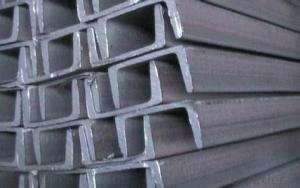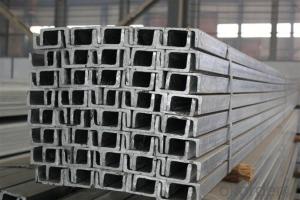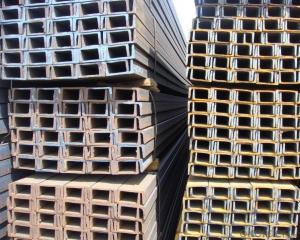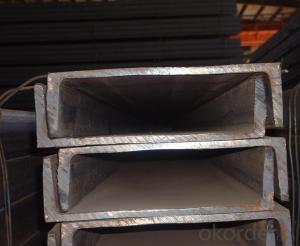Hot Rolled Steel U Channels Q345
- Loading Port:
- Tianjin
- Payment Terms:
- TT OR LC
- Min Order Qty:
- -
- Supply Capability:
- 200000 m.t./month
OKorder Service Pledge
OKorder Financial Service
You Might Also Like
Minimum Order Quantity: 25 Tons Unit: m.t. Loading Port: Xingang Port
Supply Ability: 1000 Tons Per Day Payment Terms: TT or L/C
Product Description:
Specifications of Hot Rolled Steel U Channels Q345:
Standard Applied: GB Standard, EN Standard(UPN), JIS Standard
Sizes: 50mm to 300mm
Material Grade: Q235B, Q345B, S235JR, SS400, ASTM A36
As shown in the figure:
| JIS U CHANNEL | Standard h | Sectional b | Dimension s | t | Mass: Kg/m |
| (mm) | (mm) | (mm) | (mm) | ||
| 50x25 | 50 | 25 | 3.0 | 6.00 | 2.37 |
| 75X40 | 75 | 40 | 3.8 | 7.00 | 5.30 |
| 75X40 | 75 | 40 | 4.0 | 7.00 | 5.60 |
| 75X40 | 75 | 40 | 4.5 | 7.00 | 5.85 |
| 75X40 | 75 | 40 | 5.0 | 7.00 | 6.92 |
| 100X50 | 100 | 50 | 3.8 | 6.00 | 7.30 |
| 100X50 | 100 | 50 | 4.2 | 6.00 | 8.03 |
| 100X50 | 100 | 50 | 4.5 | 7.50 | 8.97 |
| 100X50 | 100 | 50 | 5.0 | 7.50 | 9.36 |
| 125X65 | 125 | 65 | 5.2 | 6.80 | 11.66 |
| 125X65 | 125 | 65 | 5.3 | 6.80 | 12.17 |
| 125X65 | 125 | 65 | 5.5 | 8.00 | 12.91 |
| 125X65 | 125 | 65 | 6.0 | 8.00 | 13.40 |
| 150x75 | 150 | 75 | 5.5 | 7.30 | 14.66 |
| 150x75 | 150 | 75 | 5.7 | 10.00 | 16.71 |
| 150x75 | 150 | 75 | 6.0 | 10.00 | 17.90 |
| 150x75 | 150 | 75 | 6.5 | 10.00 | 18.60 |
Usage/Application of Hot Rolled Steel U Channels Q345:
The steel u channel can be applied to construction of warehouses, workshops, sport stadiums and car parks etc. In details, the steel u channel belongs to carbon structural steel which is applied to in the field of construction and machinery. The steel u channel is usually used for arch-itechtural structure, and they could be welded in order to support or hang a vari-ety of facilities. They are also usually used in combination with I beam. Generally,the steel u channel must possess perfect welding property, riveting property and mechanical property and so on.
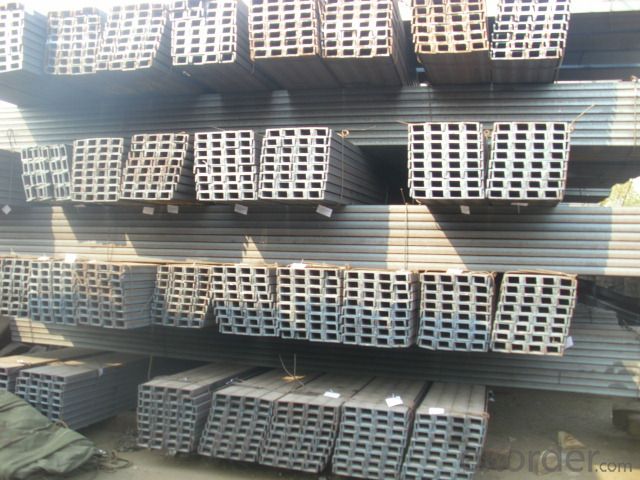
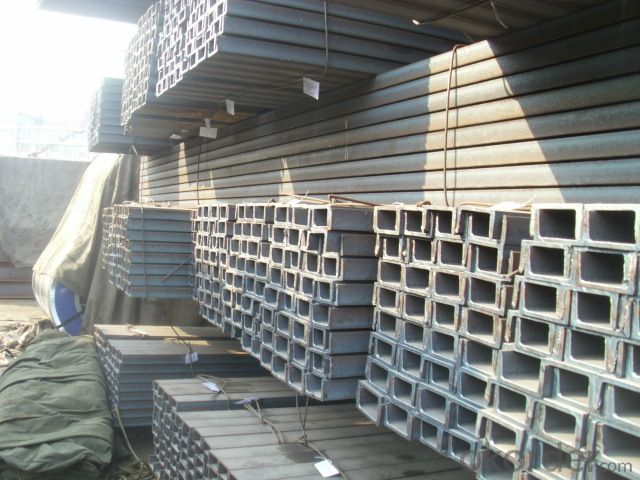
Package & Delivery: Hot Rolled Steel U Channels Q345
The steel u channel will be packed in bundle with steel wire at each end of every bundle and color marking in order to help the customer to recognize his goods more easily at sight.
And steel u channel could be loaded into 20ft or 40ft container, or by bulk cargo. If the weight of each bundle reaches less than 3.5 mt, the loading by break bulk cargo should be choosed. When the weight of each bundle reaches less than 3mt, the loading by container should be choosed.
As for the transportaion from mill to loading port, the truck will be usually used. And the maximum quantity for each truck is 40mt.
All in all, we could do in accordance with customer's request
- Q:Can steel angles be used for architectural detailing or ornamentation?
- Yes, steel angles can be used for architectural detailing or ornamentation. They are commonly used to add structural support, create unique design elements, and enhance the aesthetic appeal of buildings. Their versatility, strength, and durability make them suitable for various architectural applications.
- Q:Can steel angles be used for framing or supporting mezzanines or elevated platforms?
- Framing or supporting mezzanines or elevated platforms can indeed be achieved with the use of steel angles. In construction projects, steel angles are widely employed due to their structural strength and versatility. They serve as reliable supports or braces in various applications, including the framing of mezzanines or elevated platforms. By providing stability and structural integrity, steel angles prove to be an excellent option for bearing heavy loads and establishing a sturdy framework. Their L-shaped design facilitates easy installation and ensures exceptional resistance against bending and shearing forces. Moreover, steel angles can be effortlessly welded or bolted together, allowing for flexibility in design and construction. All in all, steel angles emerge as a dependable and efficient choice when it comes to framing or supporting mezzanines or elevated platforms.
- Q:What are the common methods of surface preparation for steel angles?
- Common methods of surface preparation for steel angles include abrasive blasting, such as sandblasting or shot blasting, to remove rust, scale, and contaminants from the surface. Chemical cleaning can also be used to remove oils, greases, and other organic materials. Additionally, mechanical cleaning methods like wire brushing or grinding can be employed to smooth out rough surfaces and remove any remaining debris.
- Q:Can steel angles be used in curtain wall systems?
- Certainly, curtain wall systems can incorporate steel angles. Typically, in such systems, steel angles function as support brackets or mullions. These angles offer structural stability and reinforcement for the glass panels or other types of cladding materials. It is possible to customize the sizes and shapes of steel angles to suit the specific design needs of the curtain wall system. Moreover, welding or bolting steel angles together allows for the creation of the desired framework for the curtain wall. In conclusion, steel angles present a robust and dependable choice for integration into curtain wall systems.
- Q:Can steel angles be used for signage or billboards?
- Yes, steel angles can be used for signage or billboards. Steel angles are versatile and durable, making them suitable for various applications, including signage and billboards. They provide structural support and stability, ensuring that the signage or billboard remains securely in place. Additionally, steel angles can be easily customized and fabricated to meet specific design requirements. They can be painted or coated to enhance their appearance and protect against corrosion, ensuring longevity and durability for outdoor installations. Overall, steel angles are a reliable and practical choice for signage and billboards.
- Q:Can steel angles be used as bracing elements in buildings?
- Bracing elements in buildings can indeed consist of steel angles. These angles are frequently utilized in construction due to their impressive strength and versatility. Their primary function is to provide lateral stability and support to structures, making them essential structural components. By utilizing steel angles as bracing elements, buildings become capable of withstanding horizontal forces like wind or seismic activity, thus preventing excessive movement or deformation. These angles are typically placed at strategic points, such as corners or intersections, and can be securely connected to other structural members using bolts or welds. The preference for steel angles as bracing elements is justified by their advantageous features, including a high strength-to-weight ratio, durability, and ease of installation. Therefore, it can be confidently stated that steel angles are a reliable and commonly employed solution for bracing elements in buildings.
- Q:Can steel angles be used in curtain wall or facade systems?
- Yes, steel angles can be used in curtain wall or facade systems. Steel angles are versatile structural components that can provide support, stability, and aesthetic appeal to curtain walls or facades. They can be used as framing elements to create the structural framework of the system or as brackets to connect various components. Steel angles offer excellent strength and durability, making them suitable for withstanding the loads and forces imposed on the curtain wall or facade. Additionally, steel angles can be customized in terms of size, shape, and finish to meet the specific design requirements of the project.
- Q:Can steel angles be painted or coated after installation?
- Yes, steel angles can be painted or coated after installation. Painting or coating steel angles after installation can provide additional protection against corrosion and enhance their aesthetic appeal. Prior to painting or coating, it is important to clean and prepare the surface by removing any dirt, rust, or contaminants. This can be done through techniques such as sandblasting, wire brushing, or using chemical cleaners. Once the surface is clean and dry, a suitable primer can be applied to promote adhesion and prevent corrosion. After the primer has dried, a final coat of paint or coating can be applied using a brush, roller, or spray. It is essential to choose a paint or coating that is specifically designed for steel and offers the desired level of protection and durability.
- Q:How do steel angles perform in terms of durability and longevity?
- Steel angles are widely recognized for their exceptional durability and longevity. Thanks to their composition, which includes a substantial amount of iron and carbon, steel angles possess remarkable strength and resistance to various forms of wear and tear. They have the ability to withstand heavy loads, extreme temperatures, and exposure to corrosive elements, thereby making them highly durable and suitable for a wide range of applications. In terms of their longevity, steel angles boast an impressive lifespan. They are specifically engineered to endure the test of time and maintain their structural integrity over extended periods. The inherent strength and resilience of steel angles ensure that they do not easily deteriorate, thus making them a reliable choice for long-term usage. What's more, steel angles require minimal maintenance to preserve their durability and longevity. Regular inspections and cleaning can effectively prevent the accumulation of rust and other forms of corrosion, thereby ensuring that the angles remain in optimal condition throughout their lifespan. Additionally, steel angles can be galvanized or coated with protective layers to further enhance their durability and resistance against environmental factors. Galvanization involves the application of a layer of zinc to the surface of the steel, providing an additional barrier against rust and corrosion. Alternatively, the angles can be coated with epoxy or powder coatings to enhance their durability and longevity in specific environments. All in all, steel angles are renowned for their exceptional durability and longevity. They offer a reliable and long-lasting solution for a variety of structural and construction needs, which explains their popularity in numerous industries.
- Q:Can steel angles be used for pipe support systems?
- Indeed, pipe support systems can indeed utilize steel angles. In construction and engineering ventures, steel angles are frequently employed due to their exceptional durability, stability, and adaptability. When employed as pipe supports, steel angles furnish a robust and dependable framework for securely holding pipes in position. They can effortlessly be joined through welding or bolting to other structural elements, rendering them suitable for a variety of pipe support applications. Furthermore, steel angles can be fabricated and tailored to satisfy specific requirements, encompassing diverse pipe sizes and load-bearing capacities. In summary, owing to their resilience and capacity to withstand substantial loads, steel angles remain a favored option for pipe support systems.
1. Manufacturer Overview |
|
|---|---|
| Location | |
| Year Established | |
| Annual Output Value | |
| Main Markets | |
| Company Certifications | |
2. Manufacturer Certificates |
|
|---|---|
| a) Certification Name | |
| Range | |
| Reference | |
| Validity Period | |
3. Manufacturer Capability |
|
|---|---|
| a)Trade Capacity | |
| Nearest Port | |
| Export Percentage | |
| No.of Employees in Trade Department | |
| Language Spoken: | |
| b)Factory Information | |
| Factory Size: | |
| No. of Production Lines | |
| Contract Manufacturing | |
| Product Price Range | |
Send your message to us
Hot Rolled Steel U Channels Q345
- Loading Port:
- Tianjin
- Payment Terms:
- TT OR LC
- Min Order Qty:
- -
- Supply Capability:
- 200000 m.t./month
OKorder Service Pledge
OKorder Financial Service
Similar products
New products
Hot products
Related keywords
